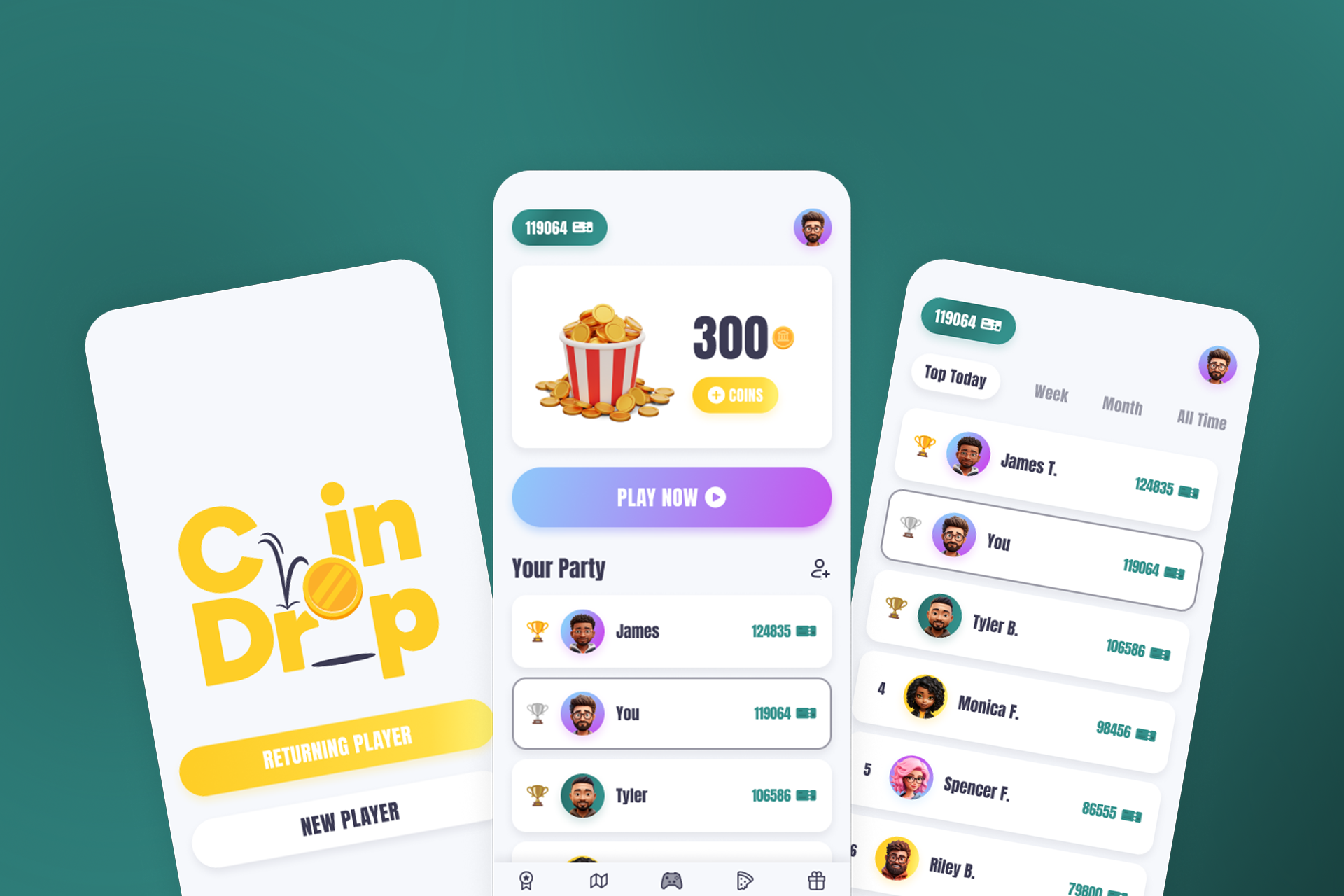
the coin drop
UX Case Study
BACKGROUND
The Coin Drop is a thriving arcade located in the vibrant entertainment hub of East Nashville. Established in 2019, they quickly became celebrated for its diverse mix of classic and cutting-edge games, comfortable seating, and clean facilities that make it ideal for groups. As a beloved community staple, The Coin Drop prides itself on offering a welcoming space where both nostalgia and modern gaming thrive. To enhance the customer experience and support continued growth, The Coin Drop is exploring digital solutions, starting with a dedicated check-in app.
ROLE
TIMELINE
TOOLS
UX Research
Prototyping
Visual Design
In Development
Figma
Visual Studios
Illustrator/Photoshop
PROBLEM
Despite its popularity, The Coin Drop faces challenges common to bustling entertainment venues. During peak hours, customers often encounter long lines at the front desk for check-ins, token purchases, or prize redemption, leading to frustration and reduced playtime. This friction can deter new visitors and negatively impact the experience for loyal patrons. Additionally, the existing manual processes for ordering food and drinks can be inefficient, leading to missed sales opportunities and further inconveniencing guests who want to maximize their gaming time. The current system also lacks a streamlined way for customers to track their progress, scores, or digital tickets, diminishing their overall engagement and the potential for a more personalized experience.
GOALS
The primary goal of developing a check-in app for The Coin Drop is to streamline the customer journey from arrival to departure. Specifically, the app aims to:
Reduce wait times at the front desk by enabling self-service check-in and digital token/game time purchases.
Enhance customer satisfaction through a more seamless, convenient, and personalized arcade experience.
Increase sales of food, drinks, and refreshments by allowing customers to order directly to their tables or gaming stations.
Improve operational efficiency by digitizing previously manual processes like ticket tracking and prize redemption.
Boost customer engagement by offering features like digital scoreboards, game progress tracking, and loyalty rewards, encouraging repeat visits and a stronger sense of community.
EMPATHIZE
Exploring User’s Pain Points
RESEARCH APPROACH
We felt a qualitative research was crucial for grounding our design decisions in real-world user experiences. Our primary research methods for this local business involved user interviews and the subsequent creation of empathy maps.
We conducted seven in-depth, semi-structured interviews with individuals representing our target demographics – from young adults who frequent the arcade with friends to parents bringing their families, and nostalgic gamers. Each interview lasted approximately 20-30 minutes and consisted of 10-12 core questions, with flexibility for follow-up probes. Questions focused on their current arcade experience, how they manage game credits, interactions with staff, social aspects of their visits, and any pain points they encountered.
This direct engagement allowed us to uncover rich, nuanced insights into their motivations and challenges. Following the interviews, we synthesized our findings into empathy maps for each participant, meticulously categorizing their map to build a holistic understanding of their perspectives.
WHAT WE FOUND
Our research revealed several recurring themes:
PROLONGED CHECK-IN + CREDIT ACQUISITION
Users consistently expressed frustration over waiting in long lines at the front desk, especially during peak weekend hours. This wasn't just about time; it was about the immediate mental shift from excited anticipation to impatience. The process of buying tokens or loading game cards felt like a significant barrier, particularly for groups who found themselves bottlenecked at a single point of entry.
PHYSICAL TOKEN/CARD MANAGEMENT
Many users, especially those with children or in larger groups, found managing physical tokens or game cards cumbersome. Tokens were easily lost or misplaced, leading to wasted money and interrupted gameplay. Cards required constant re-loading at a separate station, breaking the flow of their arcade experience and often causing arguments over who had what credits.
DISRUPTED GAMEPLAY FOR FOOD/DRINKS
A recurring complaint was the need to pause their game or leave their group to order food, drinks, or retrieve prizes from the counter. This meant missing out on game action, losing their spot at a popular machine, or simply feeling inconvenienced by having to transition from a fun activity to a transactional one. This friction often led to them purchasing fewer refreshments than they otherwise would have.
LACK OF SCORE TRACKING
Patrons, particularly social and competitive gamers, expressed a desire for a better way to track individual and group high scores across different games. The current system offered no easy way to remember which games they enjoyed, their past performance, or how many tickets they had accumulated, diminishing the sense of progression and friendly competition. Prize redemption also felt opaque, with no clear digital record of their ticket balance.
DEFINE
Establishing the User’s Needs
DEVELOPING PERSONAS
Based on the recurring patterns, behaviors, and pain points identified during our user interviews at The Coin Drop, we developed two distinct user personas. These archetypes represent significant segments of our target audience, helping us to empathize with their experiences and make informed design decisions throughout the development process. Each persona encapsulates their demographics, goals, frustrations, and the specific ways a check-in app could enhance their arcade visits in East Nashville.
Meet Maya, The Social Gamer, who thrives on shared experiences and seamless social interaction. She loves bringing her friends to The Coin Drop for competitive fun, but gets frustrated by anything that slows down their momentum or complicates group management. For Maya, the ideal arcade visit is about maximizing play and connection, free from logistical headaches. She frequently organizes outings with her tight-knit group of friends, often acting as the de facto planner for their social events.
Maya Rodriguez
“The Social Gamer”
DEMOGRAPHICS
AGE: 26
LOCATION: Nashville Native
EDUCATION: Bachelor’s Degree
JOB: Social Media Manager
FAMILY: Single or Dating
USER JOURNEY MAP
This is Dave, The Nostalgic Enthusiast. He cherishes the classic arcade experience and seeks simple, uninterrupted enjoyment. As a local from nearby Inglewood, he appreciates the familiar charm of The Coin Drop but dislikes any modern complexities that detract from that nostalgic feeling, especially when trying to share it with his family. Dave simply wants an easy, straightforward way to relive his gaming past and make new memories without fuss. He often visits with his two early teenage children, aiming to introduce them to the games of his youth and spend quality family time together.
David "Dave" Chen
“The Nostalgic Enthusiast”
DEMOGRAPHICS
AGE: 45
LOCATION: Inglewood (short drive away)
EDUCATION: Master’s Degree
JOB: High School History Teacher
FAMILY: Married w/ Teenage Children
USER JOURNEY MAP
PROBLEM STATEMENTS
By deeply understanding Maya and Dave, we formulated specific problem statements that clearly articulate the challenges they face within The Coin Drop's current system. These statements serve as our guiding stars, defining the critical issues our check-in app aims to solve:
Maya needs a fast and streamlined way to organize group arcade outings, manage shared game credits, and track competitive scores digitally because current manual processes lead to frustrating wait times and a disjointed social gaming experience.
Dave needs a simple and reliable method to acquire and manage game credits and access information without friction because physical tokens and complicated systems detract from his desire for a seamless and nostalgic arcade visit.
VALUE PROPOSITIONS
Based on our deep understanding of our key user segments, we've crafted distinct value propositions that articulate the unique benefits our check-in app offers to each persona. These statements clarify why our solution is the best fit for their needs, directly addressing their frustrations and highlighting how the app will enhance their experience at The Coin Drop.
For social gamers like Maya who are frustrated by group coordination, long lines, and fragmented experiences at arcades, The Coin Drop app is a fast and streamlined solution that transforms group outings into seamless, competitive fun. Unlike juggling physical tokens or waiting to order, our app allows you to digitally manage credits, easily track group scores, and order refreshments directly to your station, maximizing your playtime and enhancing every shared moment with friends.
For nostalgic enthusiasts like David who seek uncomplicated, classic arcade experiences but are deterred by cumbersome processes and physical tokens, The Coin Drop app offers a simple and reliable way to enjoy uninterrupted gaming and family time. Unlike the hassle of managing physical credits or leaving your game for snacks, our app provides effortless digital check-in, convenient in-app ordering, and a clear overview of your game history, ensuring your visits are all about pure, hassle-free fun.
IDEATE
Creating the Framework
BRAINSTORMING
With a clear understanding of our users' needs, defined problems, and identified opportunities, we begin brainstorming ideas. This phase is dedicated to generating a wide range of creative solutions to address the challenges faced by patrons of The Coin Drop. Our primary method for initial brainstorming involves rapid sketching, allowing us to quickly visualize and explore various concepts without getting bogged down in details.
Every sketch, no matter how rough, is a direct response to the insights gleaned from our Empathize and Define stages. Our goal is to explore how the check-in app can deliver on the core opportunities identified:
Becoming the most convenient arcade experience: We're sketching flows and interfaces that enable seamless digital check-in, intuitive game credit management, and effortless in-app food/drink ordering, all aimed at significantly reducing friction points for users like Maya and Dave.
Enhancing the social and competitive aspects: Our sketches are exploring ways to integrate digital scoreboards, robust group functionalities (for easy coordination), and intelligent personalized game recommendations that foster deeper engagement and friendly competition.
Leveraging its "mix of new and classic games" advantage: We are ideating on how the app can guide users to discover both nostalgic favorites (for Dave) and cutting-edge attractions (for Maya), ensuring that the diverse game library is a highlight, not a hidden gem.
Through this rapid sketching process, we aim to transform our understanding of user pain points into a multitude of potential solutions, laying the groundwork for selecting the most promising concepts to refine further.
Following our intensive brainstorming session, we moved to the crucial step of consolidating our ideas. We carefully reviewed all the initial sketches, identifying common themes, innovative approaches, and the most effective solutions for our defined problems. From this synthesis, we've developed a final rough sketch that integrates the strongest concepts from various iterations. This unified sketch serves as our blueprint, providing a clear visual direction before transitioning into the more detailed wireframing phase.
PROTOTYPE + TEST
Putting all the Pieces Together
MAPPING USER FLOWS
Moving from our refined rough sketches, we began to develop a typical user flow. These flows meticulously mapped out the sequential interactions and decisions a user would navigate within The Coin Drop app to accomplish key tasks. This step ensured we established logical, efficient, and intuitive pathways for our personas before we began building interactive prototypes for user testing.
VISUALIZING WITH WIREFRAMES
Following the completion of our user flows, we transitioned into creating wireframes. These low-fidelity representations brought our abstract user journeys to life, providing a skeletal framework for each screen and interaction within The Coin Drop app. By focusing solely on layout, content hierarchy, and functionality, without the distractions of visual design, the wireframes allowed us to rapidly iterate on the structural integrity and usability of our proposed solutions, ensuring alignment with our user flows and problem statements before moving to higher fidelity prototypes.
TESTING HOW USERS WILL BEHAVE
The low-fidelity prototype was ready to be put in the hands of potential users. I recruited one moderated and seven unmoderated participants for a usability study to observe how easy or difficult users found setting up parties, using digital tokens to play games, and order food & drinks. The goal of this study was to identify early usability issues and validate core user flows before investing time in a higher-fidelity prototype.
The study was designed as a series of task-based tests. The single moderated session was conducted via a video call, allowing me to observe the user's screen in real-time and ask clarifying questions about their thought process. The seven unmoderated tests were distributed remotely, which provided quantitative data on task completion rates, misclicks, and average task duration.
TASK 1
Onboarding and Account Creation
TASK 2
Create and Manage a Party
TASK 3
Ordering a Food Item
1. SUCCESS OF QR BASED TOKENS:
Observation: The single most positive feedback was for the digital token system. Users loved the convenience of scanning a QR code on a machine to apply tokens and play instantly. They found it simple and intuitive. The concept of party and local high scores was also very well-received, with users expressing excitement about the competitive element.
Insight: The core functionality of the digital wallet and social gamification is strong and should be maintained and enhanced. The current system addresses a major user pain point and creates a fun, engaging experience. I will continue to refine the token management interface, building on the positive foundation of the QR code system.
2. POSITIVE FEEDBACK ON PARTY CREATION & MANAGEMENT:
Observation: Users were delighted by the straightforward process of creating a party and found the editing functions very easy to use. They particularly enjoyed the simple interface for adding friends. The only noted pain point was the lack of a clear way to remove a player once they had been added to the party.
Insight: The party creation flow is highly successful and meets user expectations for ease of use. The one key feature missing is the ability to remove players, which is a necessary function for managing group dynamics. The next design will include an intuitive way for users to edit and remove guests from their party.
3. STREAMLINED FOOD & DRINK ORDERING:
Observation: Participants found the food and drink ordering system to be simple and convenient. They appreciated the ability to order from their phones. The primary area for improvement noted was the navigation: users sometimes felt lost when trying to return to a previous menu and would accidentally navigate back to the main game screen instead.
Insight: The ordering system itself is effective and should be maintained. The navigation, however, needs to be refined for better usability and consistency. I will implement clearer back buttons with more specific labels to ensure users can intuitively return to the previous menu without losing their place.
ADDITIONAL NOTES:
Map Feature: Many users felt the included map of the arcade was excessive and not useful in the current prototype state. However, the client is adamant about including it. Therefore, I will redesign the map to be a more useful tool, perhaps with clearer points of interest and more relevant information, and move it to a less prominent location to avoid clutter.


